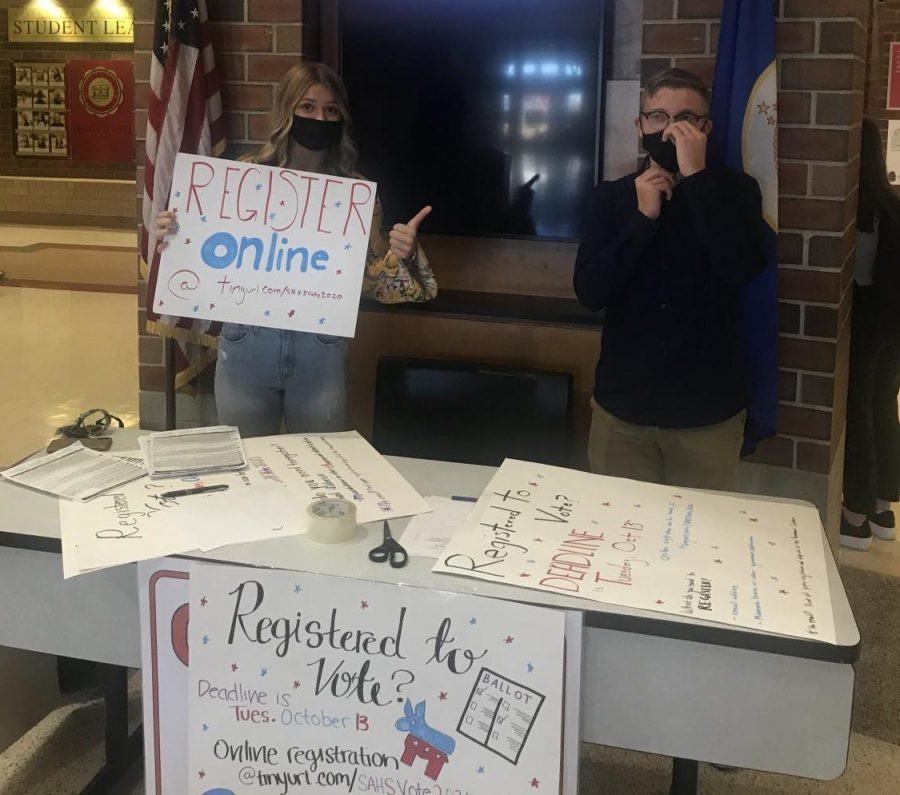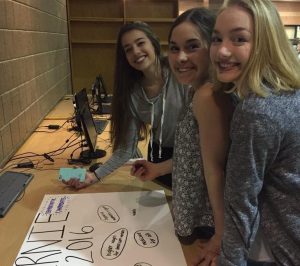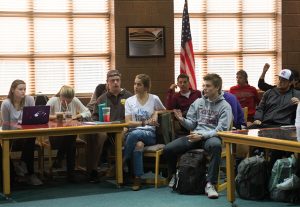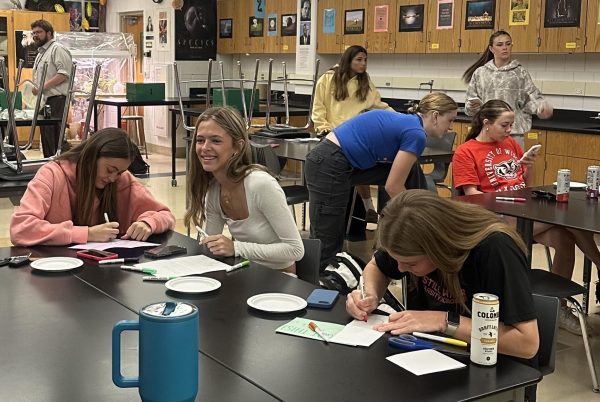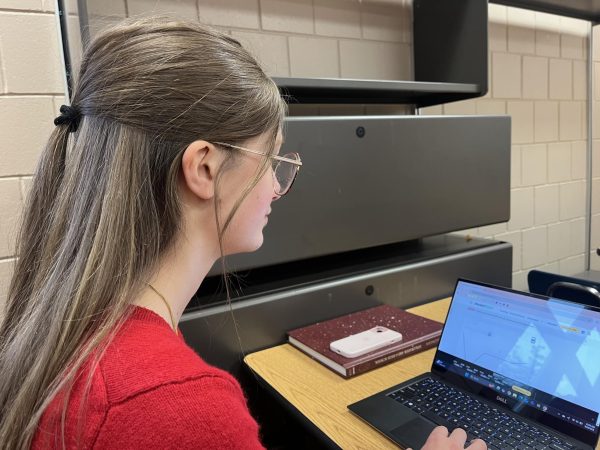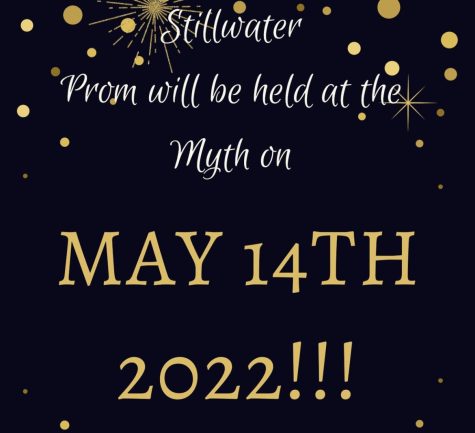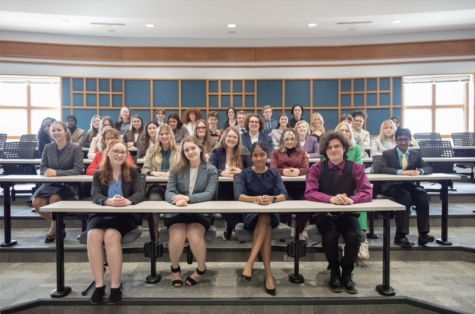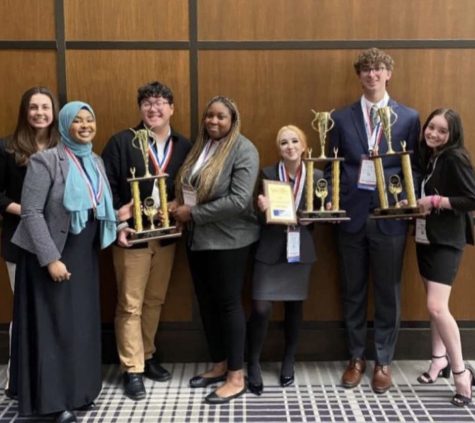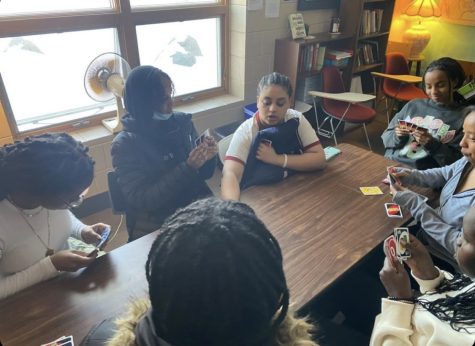Political clubs help build mutual understanding
Seniors Alex Steil and Natalie Loehr try to bring in students to their voting booth. On Oct. 12 and 13, the Young Democrats and Young Republicans ran a booth in the main rotunda to register seniors that are eligible to vote.
Three girls were huddled around a large piece of cardstock, joking behind masks as they tried to draw an elephant. Arguments over whether the grand old logos trunk went up or down and which color went on top was scattered between jokes about the fly that landed on Mike Pence in the previous night’s debate and gossip about the election. The group was part of 10 people huddled into a classroom drawing up posters in the hopes that, after this first meeting of their club they could convince students to “Keep Calm and Join Young Republicans.” For the students here the club is a zone where they can feel safe to speak about their opinions.
“Our main goal is to create a community of like-minded people,” senior Eliza Darby, Young Republicans member, said. “We’re not here to bash anyone’s political beliefs.”
Darby is not alone, as the country has slowly devolved into a more volatile political climate, student organizations are working to make the high school a safe place for political expression.
Political polarization is the term usually reserved for the phenomenon of an unstable political system caused by radicalism. While it has been a problem since the beginning of the country, the modern phenomenon has its origins in the 1968 election, which saw a large wave of political unrest and controversy that helped create a polarized climate or one in which the major parties were pushed to two sides of the ideological spectrum.
Since then, parties have slowly been moving to new extremes: Republicans have gone from the soft-spoken conservatism of Reagan to the Rightist populism of Donald Trump. Leaders of the Democratic party have also shifted from historically being centrists and neoliberals to progressives and socialists today. This state of affairs has led to turbulence and sometimes even violence that is beginning to spill over into everyday life.
Generally, while Washington county has been subject to the same changes as the rest of the country, the high school has been able to make an environment that is suitable to some, but recently students have began to be fearful of expressing their views.
“I would define myself as a conservative,” sophomore Caleb Tussey said. “I do not think that many people hold my views in Stillwater because I feel kids go with the majority and don’t want to be called names.”
Meanwhile, senior Olivia Hovland, co-president of the Young Democrats, said she believed that Washington County was a more conservative region and this carried over to the high school where she had witnessed students ripping Young Democrats and BLM posters throughout the school and wearing confederate memorabilia with little to no repercussions.
The problem goes beyond just disrespect, but also a general trend of misinformation. According to Pew research, most Americans rely on political candidates and ill reputed media instead of more respected outlets. This has led to widespread belief in conspiracy theories and a reliance of insults, hurting the hope for peaceful dialogue between the two sides.
However, clubs like the Young Democrats have been working to fight this trend. On the Friday following the Young Republican’s first meeting, the group met virtually. (The club had moved to Zoom meetings earlier this year due to safety concerns connected to the coronavirus pandemic) in order to interview Josiah Hill, a DFL candidate for State Senate. By the end of the meeting, 19 members had gathered in order to hear and ask questions about how to get involved in campaigns, and those attending were enthusiastic.
“I think something so challenging with students below the voting age is having strong political beliefs and asking, ‘what can I do as a minor?’” advisor Rebecca Skogen explained. “I think a major goal for our club is raising awareness of politics on not just a national, but on a local level and getting kids involved. That includes guest speakers, volunteering opportunities; in the past I know we’ve helped get students to aid in caucuses and political campaigns.”
Another important aspect of the Young Democrats that has been trying to ensure that students are informed and educated on current events, and they have done this through the creation of a community that allows people to express their political beliefs in a safe environment while also being informed on the issues.
Senior Natalie Loehr, Co-president of the Young Republicans similarly said the Young Republicans hoped to foster understanding between people from different backgrounds.
Both clubs have already begun to collaborate, running a booth in the main rotunda to help register students to vote in the election on Nov. 3. They have discussed a possible debate between the two clubs in the future to help promote understanding between party lines.
“In the political climate that we’re in,” Loehr said , “we need equal political representation at the high school to avoid a single-track mindset.”
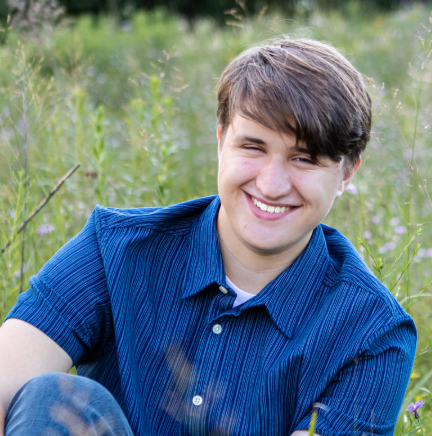
My name is Andrew Jurek and I’m a senior Layout editor-in-chief this year. I also enjoy reading (when I have the chance) but I spend most of my time...


